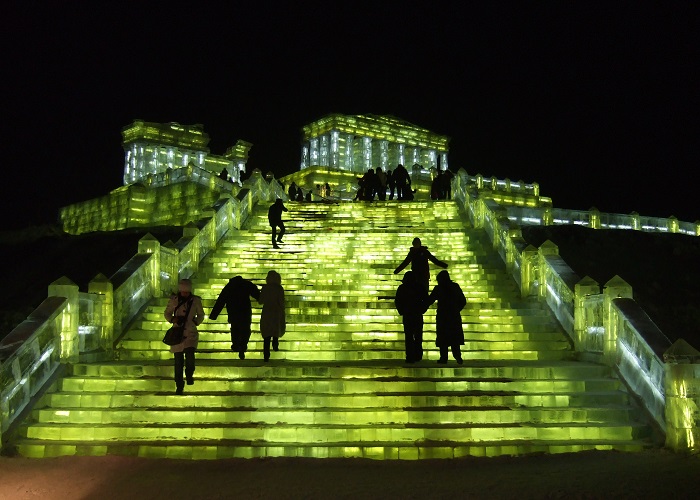1) Guilin – Venture outside Guilin to Yao Mountain for panoramic views of the city. Don’t miss a visit to the Tea Research Institute which was the Royal Tea Garden in the Ming Dynasty. It’s less commercialised than the Tea Institute in Hangzhou and you can have a full presentation about Chinese tea culture.
2) Yangshuo– Visit one of many villages around Yangshsuo and see how China lived a hundred years ago and more. My favourite is Chaolong Village which consist of three villages whose houses are built from mud. The village is on the way to the 400 year old Yulong Bridge, another sight which must be visited. In the evening visit the The Liu Sanjie show, created by the famous director Zhang Yimao, who also choreographed the opening ceremony for the 2008 Beijing Olympics.
4) Chengdu– You can visit pandas in the city centre of Chengdu but the best place to see pandas in China is at the Ya’an Bifengxia Panda Base which is located in Bifengxia Town, Ya’an City, to the south-west of Sichuan Province. There are two UNESCO sites easily accessible on the way to Bifengxia: Leshan, the largest Stone Buddha in the world which was carved out of the cliff to please the Gods and to stop regular flooding in this area. The Buddha is facing another UNESCO site, Mt Emei, which is one of the Four Sacred Buddhist Mountains of China.
If you are going to board a Yangtze cruise in Chongqing make a small detour to visit another UNESCO site – the beautifully- reserved 7th century Dazu Rock Carvings showing the three major religions in China: Buddhism, Confucianism and Taoism.
5) Pingyao –the best ancient walled city in China built in the shape of a turtle which according to Chinese superstition brings longevity. You don’t need a guide and driver (it’s pedestrianized) and the city is so small that you can go sightseeing on your own. Visit the first bank in China, Rishengchang Exchange House, or check how government officials worked and spent their free time at the Yamen, County Government Office. Don’t miss a visit to Qiao’s manor house which was used for the film “Raise the Red Lantern”, the movie by made by Zhang Yimao. The whole town is a UNESCO site.
6) Harbin– it’s worth a visit during the Ice and Snow Festival which starts on the 5th January and lasts until the weather warms. The temperature is usually minus 25 degrees but sightseeing can be done between noon and 3pm. Apart from the Ice and Snow Sculptures, visit the Siberian Tiger Park where more than 100 roam freely. Discover the Russian influence on this northern corner of China by visiting St Sophia’s Church built in 1903. I haven’t visited Harbin during the summer months but I hear it’s more humid than in Beijing, which is not surprising as the Gobi Desert is not far away.
7) Chengde– this neglected city of China was the summer resort of the early Qing Dynasty emperors. Visit the Summer Resort and Outer Temple which are a UNESCO site. You can reach Chengde by car or by train. If you are going by car stop at the less commercialised part of the Great Wall of China – Jinshaling.
8 ) Kunming– where you find many minority groups. Usually Kunming is used as a stopover before continuing north to Zhongdian and the Tiger Leaping Gorge but there is so much to see in Kunming – the Bamboo Temple and delicious vegetarian food made by monks, the biggest Botanical Garden which was host to the International Camellia Congress, the Golden Temple which is the best preserved Taoist temple in China. I would avoid a visit to the Stone Forest – it’s too faraway and too commercialized.
09) Qingdao – a sea port once under Germany’s influence whose Bavarian architecture can be found throughout the city – the Ambassador’s Residence, the Church, the beer factory. Host of the Olympic Sailing Regatta during Beijing Games and host to the biggest beer festival in the world every August. Walk on the Trestle Bridge, a pier with a pagoda at the end. If you have time climb one of the four Sacred Taoist Mountains in China, Mt Laoshan or take a fast train to Yantai and do a wine tasting.
10) Water Villages around Shanghai – so many of them: Wuxi, Wuzhen, Suzhou, Hangzhou, Zjoujiang, Xitang… and they are all beautiful in their own way. We recommend Anchang Water Village, easily accessible on a day tour from Shanghai, unique, small and still not commercialised. Try the local wine or the local sweets still made as they have been for a thousand years.



















